The ASUS ZenFone 2 Review
by Brandon Chester on May 26, 2015 8:00 AM ESTSystem Performance
To test Intel's Atom Z3580 SoC I've run the phone through our standard suite of benchmarks. These tests range from browser tests that test the speed of the SoC and the browser's Javascript engine, to more native tests like writing text and seeking through videos. Even some tasks that seem simple can be quite demanding on devices where the entire system is limited to a power envelope of around 3W. Luckily, the ZenFone 2 runs Android Lollipop and so it's using Google's new ART runtime for Java based Android applications. However, even ART is limited in what it can do, as AOT compiler optimizations are limited by a need to balance the CPU's limited power with the need to compile apps quick enough that the user isn't stuck waiting long after they are downloaded.
Although it's a bit unfair as it's a tablet, I've included Dell's Venue 8 7000 in these results because it uses the same SoC as the ZenFone 2 and so it makes for an interesting comparison.
As usual, the first tests that I'll be looking at are our browser benchmarks. Sunspider had become such a large optimization target that it's basically gone from our 2015 benchmark suite, which leaves us with Kraken, Octane, and WebXPRT 2013.

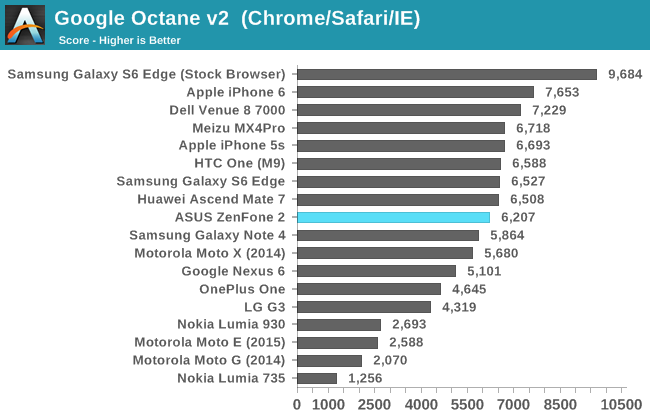
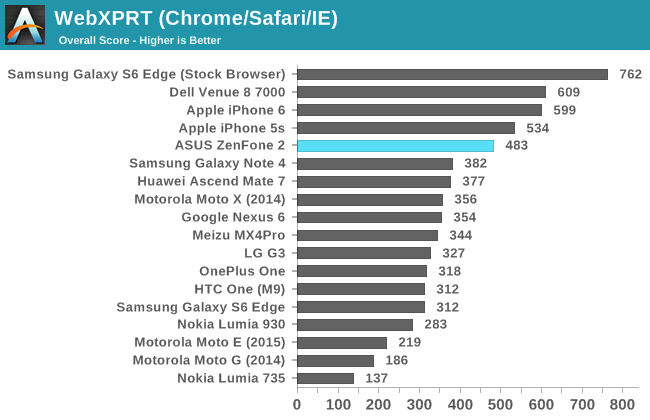
In our web browsing tests the ZenFone 2 performs very well. In the case of Kraken, it does roughly as well as the Venue 8 7000 which uses the same Z3580 SoC. Performance tends to fall behind the Venue 8 in our longer tests like Octane and WebXPRT. I don't have the Venue 8 anymore, but it's a safe bet that this is due to the larger aluminum chassis of the Venue 8 being able to manage heat better in order to keep the clock speeds on the CPU higher during the course of the test.
While the ZenFone 2 isn't quite as fast as a tablet using the same SoC, it's much faster than most of the other devices that we've tested. In general it ends up being a bit slower than the iPhone 5s and the iPhone 6, and of course it loses to the Galaxy S6 using Samsung's browser by an enormous margin in every case. However, a good portion the phones that sit below it are very expensive flagship phones like the Nexus 6, LG G3, and the Galaxy Note 4 which is very impressive for a $300 smartphone.
The next test is Basemark OS II which tests the performance of a device's CPU, GPU, RAM, and NAND.
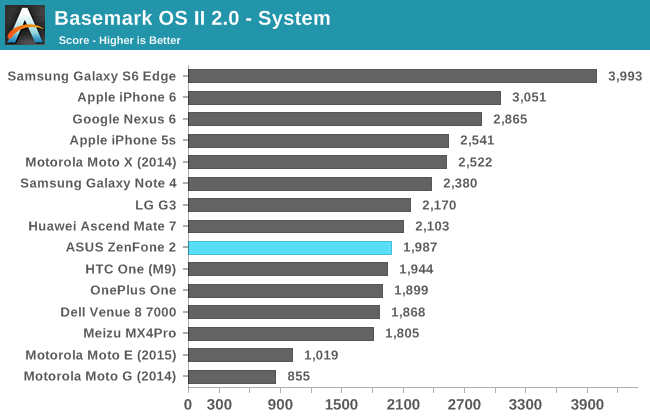
The system sub test performs integer and floating point operations, and also performs some tests like XML parsing. This makes it primarily a test of the device's CPU and RAM. I'm actually somewhat surprised by the ZenFone's performance in this test. By no means is it bad, but I had forgotten that the Venue 8 also struggled to match Snapdragon 801 smartphones in this test.
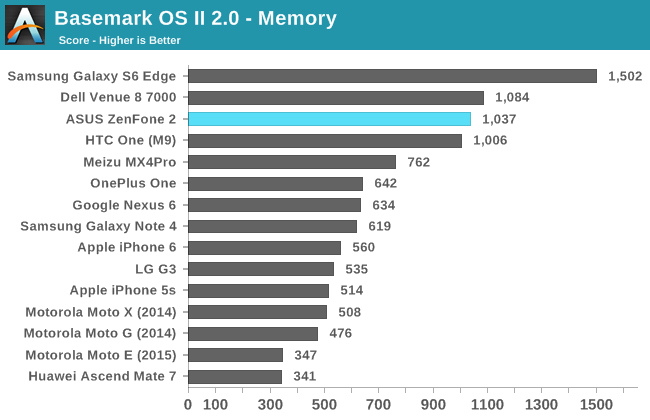
The Basemark OS II memory sub test has a somewhat vague name. While one might expect it to be a test of the device’s RAM, it’s actually a flash storage test. In it we see one of the highest scores of the smartphones we’ve tested, with only the Dell Venue 8 tablet and the Galaxy S6 with its UFS memory achieving higher scores.
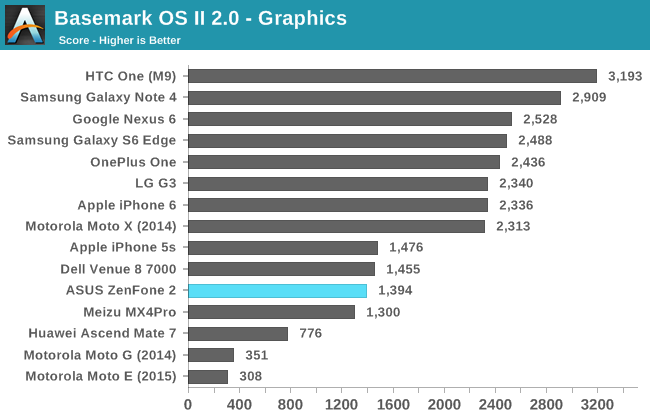
The result in the graphics test is definitely on the lower end of our results, but it’s not unexpected. Both the Venue 8 7000 and the iPhone 5s achieve similar scores, and all three devices use the same G6430 GPU (albeit with lower clock speeds on the iPhone). Even though the ZenFone 2 doesn’t perform as well as the expensive flagship smartphones, it’s far ahead of budget devices like the Moto G. Since both the Z3560 and Z3580 based ZenFone 2 models use the same 533MHz PowerVR G6430 this result should be roughly the same on the $199 model as it is on this $299 model.

The last sub test is the web test. This test focuses on a device’s ability to handle web page rendering, with a focus on HTML5 and CSS rather than Javascript code. In this test we see the ZenFone 2 amongst a large group of devices that includes the HTC One (M9), the Nexus 6, and the Moto X. To see the same level of performance as Snapdragon 805 and 810 devices is very impressive.
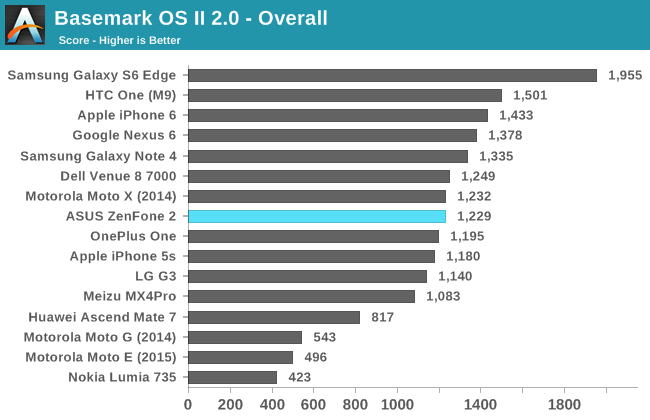
The overall score for BaseMark OS II takes into the account the scores of the various sub tests to generate a final score. In this test we again see the ZenFone 2 around the middle of the pack, with a score that is similar to that of Snapdragon 801 based devices. This is a very good result for a smartphone that costs so little, although the OnePlus One also achieves similar performance at roughly the same price as the $299 model of the ZenFone we are testing.
Our last general performance benchmark is PCMark. This is a relatively new addition to our testing workflow, and it focuses on race to sleep scenarios that reflect the type of usage a device will see in the real world. The tests range from Javascript performance, to playing and seeking in videos, to editing photos.

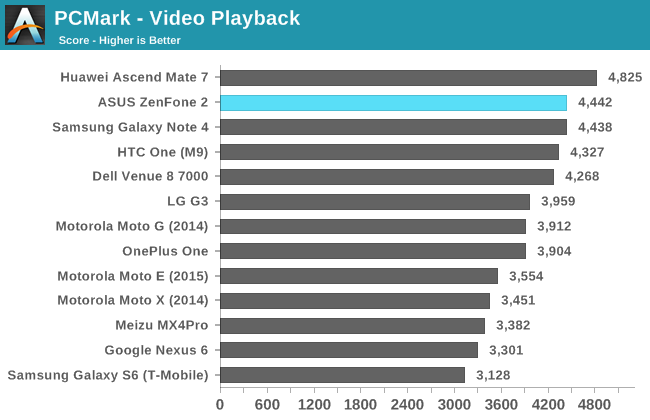
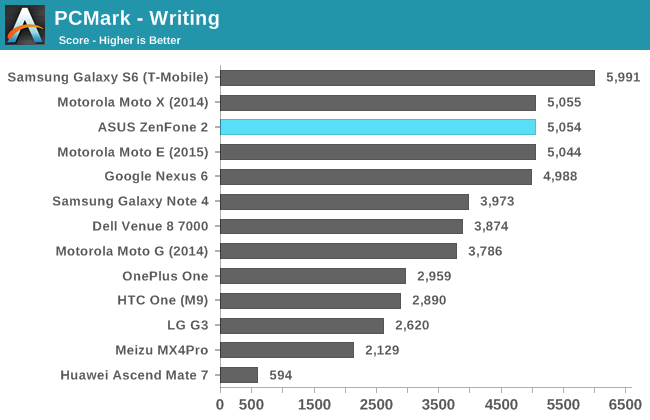
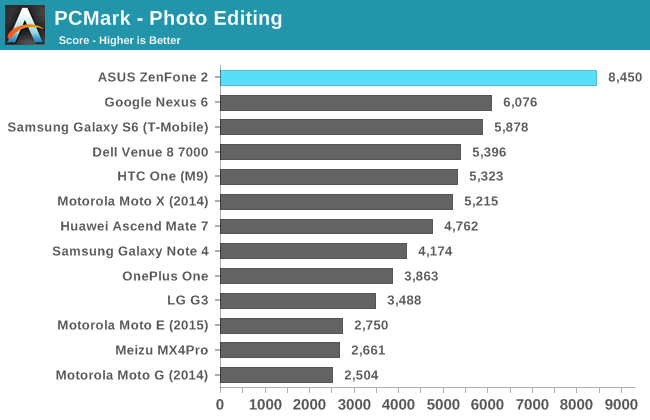
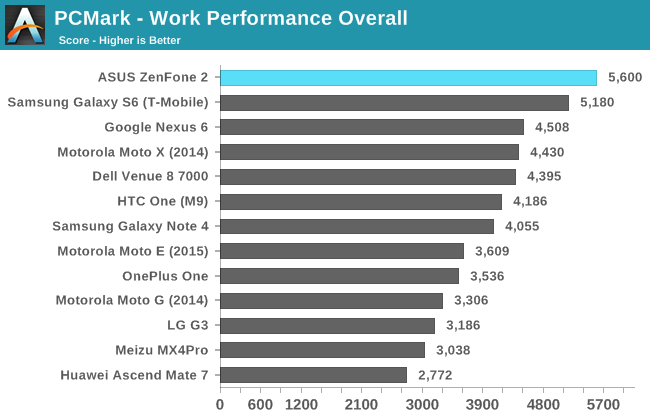
In all of the PCMark sub tests the ZenFone 2 performs extremely well. It’s always at or very close to the top result, and only really loses by a large margin to the Galaxy S6 in the tests that it isn’t right near the top for. The one exception is the photo editing test where it beats every other device by an enormous amount. This score is what carries it to the top position when it comes to the overall score.
I think it’s a bit unfair to say that the ZenFone is the fastest device when it only comes first in a single test, but even without considering the photo editing test it’s clear that the ZenFone 2 offers great performance. Even more amazing is that at times it can trade blows with flagship phones that cost much more than it does. Perhaps due to the fact that it's the only x86 Silvermont-based phone in our benchmarks its relative performance can bounce around versus the competition, but on average it comes rather close to delivering the kind of CPU performance we've seen from the flagship phones over the past year.










147 Comments
View All Comments
re2onance - Friday, May 29, 2015 - link
nm, apparently that isn't correctmeacupla - Tuesday, May 26, 2015 - link
ok, done deal for a protective case for this thing then.blzd - Thursday, May 28, 2015 - link
That's one of the issues with larger phones such as this.jjj - Tuesday, May 26, 2015 - link
Actually in many markets the top Zenfone does compete with the G3 , S5 and the likes on price. Asus isn't quite hitting the 300$ + tax price everywhere and older flagships do get cheaper. The currency drops in some markets are not helping them either. The 200$ model is better value but it competes with A53 based devices that can be plenty cheaper with similar specs In China the TLC Meme da 3S ( 5inch 1080p , SD615 , 2GB RAM , 16GB NAND , 13MP and 8MP cams ,3050mAh ,139.6x69.6x8.9mm ,130g) just launched at 799CNY and that's 129$. Differences aside, they do have to compete with such devices. For the 300$ device you also got the soon to arrive SoCs, spending 300$ on this now might feel like a mistake in a few months.Wish you had the 1.8GHz 4GB RAM and 2GB RAM versions (they do have a lower clocked 4GB version) to compare battery life. In browsing the 4GB of RAM might be what kills it so fast.
Always wanted to ask about the LTE battery test , how much of the time time is idle or each of the LTE power states. Or maybe even better, how much data is used per minute or hour or w/e. Americans can afford to use a few GB per month but most of the world uses 10 times less or worse. In any case, the daily average usage is from almost 0 to bellow 200MB so LTE is most of the time idle if not disabled. Knowing how much data you use in testing battery life would help understand the relevance of the test and maybe help you better calibrate it in the future. So any chance you can provide some (rough) estimate on data usage when doing that test? Right now we have no idea if it's 60MB per hour or 10 times less and that's a huge range.
menting - Tuesday, May 26, 2015 - link
Frankly, I don't think the difference in 4GB RAM and 2GB RAM should make that much of a difference. A difference of doubling the refresh rate in the DRAM, as well as the difference in idle power should be peanuts compared to to what the other components are pulling.Glock24 - Tuesday, May 26, 2015 - link
I'm also interested in knowing if there's any difference in battery life between the 1.8GHz 2GB and 2.33GHz 4GB version.Some people in forums are saying the 4GB version drains the battery faster, some say the high battery drain was due to some bug in Lollipop. Maybe this was already addressed in a system update? All those comments about poor battery life of the 4GB phone come from people using the TW or India version with factory software version (which I assume is older than that on the US version). But still, would be interesting to know for sure if the 2GB version has better battery life.
I've read some people complain about the phone overheating, but there's no mention about temperatures in the review. Does it get hot during heavy use? Does it become so hot it's not comfortable to hold?
In the review Brandon talks about preinstalled bloatware, but does not mention about any useful bundled software. For example, I've read in other reviews about a bundled app that gives the user granular control over which applications run in the background and which ones are allowed to autostart, without the need for the phone to be rooted.
Also Asus gives you 5GB storage in Asus's own service with each device. How well or bad does the Asus Cloud app work? Does it make automatic backups? Is it easy to setup or use?
Chinaphonearena - Tuesday, May 26, 2015 - link
An outstanding review, man. Truly. I hope you don't mind me plugging my own of the 2gb/16gb/1080p model. It's not nearly as technical or thorough as this, but some may get something out of it.http://www.gizbeat.com/7449/asus-zenfone-2-full-re...
Also the tear down of the phone from a Taiwanese user, which shows some of the components Asus is using.
http://www.gizbeat.com/7622/take-a-look-inside-the...
ketacdx - Tuesday, May 26, 2015 - link
I have a TW 4GB model and its been getting 2 software updates a month fixing little things here and there on top of the ZenUI updates. I have not had any overheating or even it getting warm. My Nexus 5 from before this got way more hot. There is an Auto-start manager which is kind of neat but 80% of the preinstalled stuff is useless. Luckily most of it can be uninstalled and not just disabled which is cool. I don't know about the US model but the TW model gives me 100 GB's of free Google Drive storage for 2 years. I am in Canada and it enabled fine. I have never used to Asus cloud so I don't know how much they provide.Manch - Tuesday, May 26, 2015 - link
I'd like to see Windows Mobile loaded onto this and the benchmarks run again. Is that possible? MS said they would release a ROM that could be installed over android.Gich - Tuesday, May 26, 2015 - link
I think they made only a ROM for Xiaomi Mi4...